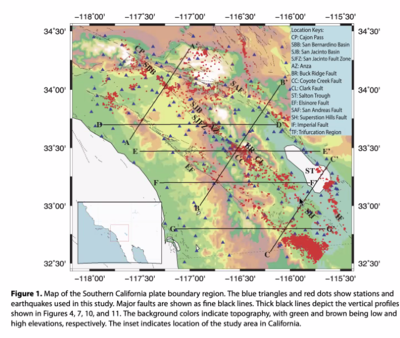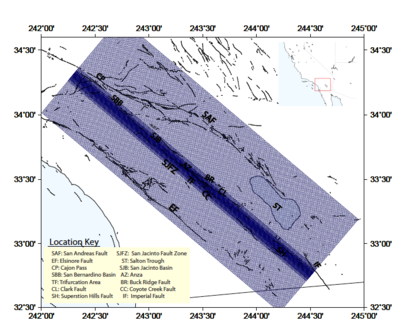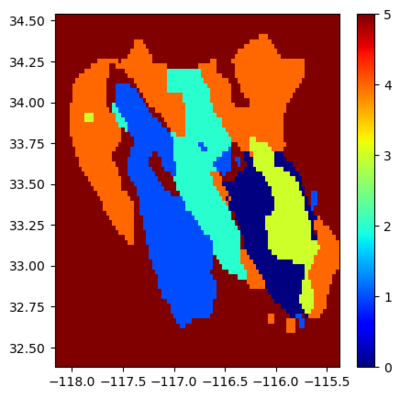BBP Strong Ground Motion Project
Contents
Southern California Plate Boundary Velocity Model
The paper Fang et al defined a Southern California Plate Boundary Velocity model.
The max depth is 20 km; the model should be merged with a regional model to have information below that depth but it is not clear how to do this smoothly.
We are looking at the Vp, Vs models of the Fang et al. (2016) pape. , and also the Fang et al. (GJI, 216, 609–620, doi: 10.1093/gji/ggy458.2019) paper that has better Vs results, and classify the results using K-means clusters as done by Eymold and Jordan (2019). We found that 6 clusters (data types) can account for most of the data. This is preliminary but can help to decide how many distinct 1D velocity models are needed for the region around the SJFZ. More work is required to decide how to merge the results with a regional model.
Model Figures
| Image | Figure |
|---|---|
| SCPB Velocity Model Map | |
| Sensor Net Distribution | |
| So. Calif Velocity Regions |
Related Papers and Datasets
- Fang Southern California Plate Boundary Velocity Model (SCPBVM)
- BBP Graves and Pitarka Method
- BBP Goulet Validation Paper
- Taborda Ground Motion Paper
- Ely/Jordan Vs30 GTL Study
- Maechling BBP Software Paper
- Fang SCPBVM model data files
AGU Abstract
Evaluating the Impact of Alternative Seismic Velocity Models on Simulated Ground Motions from Large Magnitude California Earthquakes
Philip J. Maechling, Fabio Silva, Robert Graves and Yehuda Ben-Zion
Ground motion simulation methods implemented in the SCEC Broadband Platform (BBP) are designed to simulate strong ground motions at levels of engineering interest. The simulation methods have undergone extensive verification and validation efforts involving comparison of simulated results to Ground Motion Prediction Equations (GMPEs) and to the observed ground motions from historical earthquakes. The ground motion simulation methods implemented in the platform propagate seismic waves through a region-specific 1D velocity model, and typically a single 1D velocity model is selected for each validation earthquake. Recently, dense seismic arrays and other methods have produced detailed velocity models for Southern California that often resolve near surface layers better than earlier models. The goal of this study is to use the BBP with multiple 1D velocity models in a region, to study the impact of the different velocity models on the simulated ground motions. We use the Graves and Pitarka ground motion method as implemented in the BBP and large scenario earthquakes on the San Jacinto Fault and the Newport Inglewood Fault consistent with high probability UCERF3 ruptures for Southern California. Initial results in comparison with baseline ground motions using the existing BBP region-specific 1D velocity models will be presented in the meeting.


